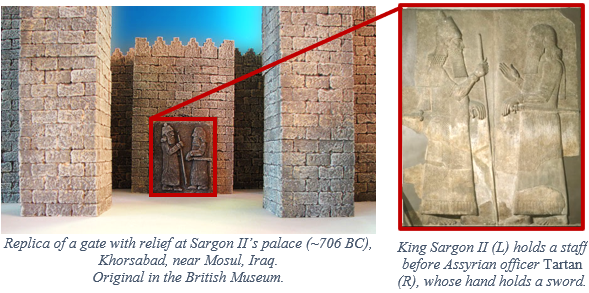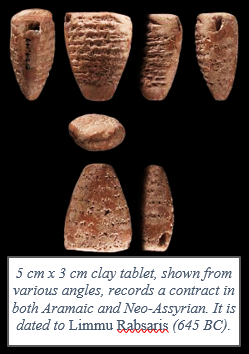In 2 Kings 18:17, we read the king of Assyria [Sennacherib] sent Tartan and Rabsaris and Rabshakeh from Lachish to king Hezekiah at Jerusalem around 713 BC. Who were these people, and why did he send them? Since no classical Assyrian historian mentioned them, confusion as to their identity abounded, leading men to doubt God’s Word. Yet in 1847, vital insights about these men came from the Assyrian Limmu list. This artifact lists Assyria’s kings and events annually, as recorded by a selected high ranking official, called the Limmu (see MBC bulletin, July 17, 2022).
Tartan. The first named messenger sent to Hezekiah was Tartan, who worked for Sennacherib in 2 Kings 18, and for someone else in Isaiah 20:1a, where Tartan came unto Ashdod, when Sargon the king of Assyria sent him. Unbelieving and even faithful Bible scholars such as Dr. John Gill resolved the apparent contradiction by claiming Sargon, unmentioned by ancient historians, was Sennacherib. However, with the discovery of Sargon’s palace in Khorsabad in 1843, no one today believes the two kings are the same (Sargon was his father). It turns out that the Limmu for 856 BC is none other than Tartan, the chief of the army. Tartan is title meaning “commander in chief”, second only to the king. Sargon II was depicted facing his Tartan on a nine feet tall gypsum bas relief (see below).

 Rabsaris. The Bible records little of Rabsaris, and historians knew even less until a heart-shaped tablet was unearthed at Nineveh (right). It records a contract where Hamatutu of Handuate got a 33% interest loan from the king’s son to obtain five homers of barley. It was officially dated to “Limmu of Rabsaris Nabu-sar-usur” (or, 645 BC). This means Rabsaris is merely the title of a high-ranking Assyrian official, here named Nabu-sar-usur. While his exact role remains obscure, his title was apparently well-known that even the poor knew to reference him in a deal.
Rabsaris. The Bible records little of Rabsaris, and historians knew even less until a heart-shaped tablet was unearthed at Nineveh (right). It records a contract where Hamatutu of Handuate got a 33% interest loan from the king’s son to obtain five homers of barley. It was officially dated to “Limmu of Rabsaris Nabu-sar-usur” (or, 645 BC). This means Rabsaris is merely the title of a high-ranking Assyrian official, here named Nabu-sar-usur. While his exact role remains obscure, his title was apparently well-known that even the poor knew to reference him in a deal.
Rabshakeh. The Bible twice records Rabshakeh’s blasphemous words against the Lord, making him infamous among the ambassadors. For centuries, no one knew about him either, until the Limmu list was deciphered. The next after Limmu Tartan was Limmu Rabshakeh in 855 BC. He likewise was referenced by his official title and not his name. He had some type of military role but could possibly have also been the king’s cupbearer. His knowledge of Hebrew implies a diplomatic office.
In summary, the Assyrian king Sennacherib appears to have sent his highest-ranking military general, official record keeper for the year, and top ambassador to king Hezekiah. In 400 BC when Herodotus and Xenophon wrote what little knowledge of Assyria remained, these three officials were lost to classical history; however, the author of 2 Kings 18 did not write centuries after-the-fact, but as an eyewitness. Furthermore, both Isaiah and Jeremiah prophesied of Judah’s exile into Babylon during a time when Assyria was the superpower, not Babylon. Isaiah also wrote of Cyrus (Isaiah 44:28, 45:1) as a deliverer 150 years before his rise to power along with Persia’s subjugation of Babylon. The Bible’s historical accounts remain accurate, and its prophecies are not “post-dictions” but predictions. When will men quit doubting the veracity of God’s Word? I am God, and there is none like me, declaring the end from the beginning, and from ancient times the things that are not yet done, saying, My counsel shall stand (Isaiah 46:9b-10a).
Sources: MindRenewers.com, AncientReplicas.com, & British Museum. Most explain Sargon II faces his son Sennacherib, but royalty hold scepters not swords.
Like this? Consider sharing it to Facebook by clicking the linked icon below.
